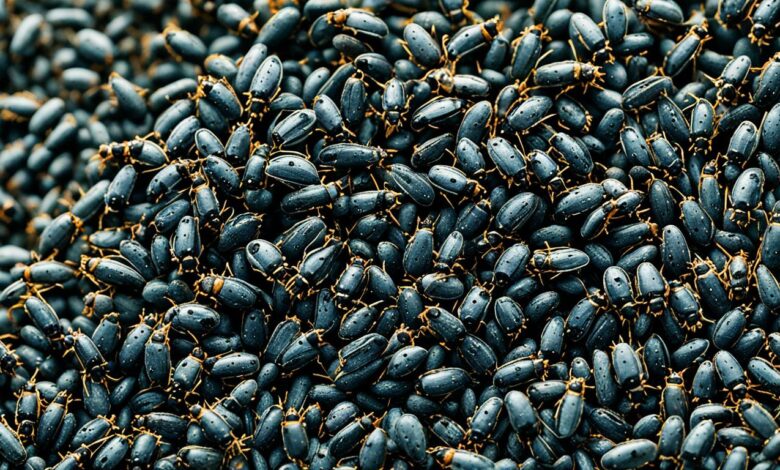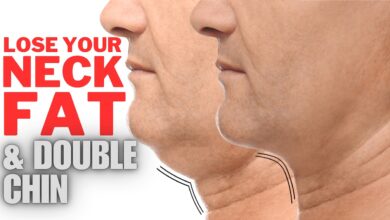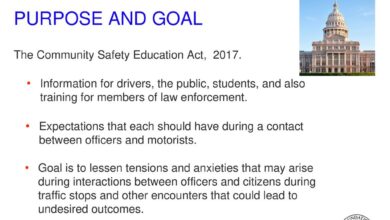Tiny Black Bugs Look Like Poppy Seeds: What Are They?

Have you seen tiny black bugs that look like poppy seeds in your home? These small pests can be hard to identify. They could be ticks, bed bugs, carpet beetles, or booklice. Knowing which bug you’re dealing with is key to solving the problem.
Some of these bugs can be harmful to people and pets. Ticks and fleas might spread diseases. Carpet beetles and booklice can damage fabrics and food. Identifying the bug is crucial for taking the right action.
Let’s explore these poppy seed-like bugs and their traits. We’ll discuss how to spot them and get rid of them. This guide will help you tackle any bug problem in your home.
Key Takeaways
- There are several types of tiny black bugs that resemble poppy seeds, including ticks, bed bugs, carpet beetles, and more.
- Some of these pests can pose a threat to human and pet health, while others can cause damage to household items and stored food.
- Proper identification is crucial for determining the appropriate course of action to address the infestation.
- Contacting a professional pest control technician may be necessary if DIY methods are unsuccessful.
- Preventing future infestations by maintaining a clean and well-organized home is essential.
Ticks: Tiny Arachnids Resembling Poppy Seeds
Ticks are tiny arachnids that look like poppy seeds. They live in wooded and grassy areas. These small bugs can spread dangerous illnesses like Lyme disease.
Ticks range from poppy seed-sized to pencil eraser-sized. Their size depends on their life stage and feeding status.
Identifying Ticks and Their Potential Dangers
People often mix up ticks with bed bugs. Ticks have eight legs and cling tightly to skin. They look flat before feeding but swell up after.
Tick-borne illnesses are a major worry. They can cause rashes, fever, and flu-like symptoms. These conditions need quick medical care.
Preventive Measures to Avoid Tick Infestations
- Wear protective clothing, such as long pants and long-sleeved shirts, when spending time outdoors in grassy or wooded areas.
- Use EPA-registered insect repellents containing DEET, picaridin, or other effective active ingredients.
- Perform regular tick checks on yourself, your family, and your pets after being in tick-prone environments.
- Maintain a well-trimmed yard and remove leaf litter, tall grass, and brush to create an unfavorable habitat for ticks.
Stay alert to tick risks. Take steps to prevent infestations. This way, you can enjoy outdoor activities safely.
Bed Bugs: Small, Flat Insects Mistaken for Poppy Seeds
Bed bugs are tiny, flat, and reddish-brown insects that look like poppy seeds. They belong to the Cimex genus and live in homes and hotels. After feeding, they swell and become rounder.
These pests mainly eat human blood. They leave rust-colored stains, shed skins, and dark excrement behind. Despite their small size, bed bugs can be a big problem.
Over 90 bed bug species exist worldwide, with 15 in North America. They start as eggs and grow through five stages before becoming adults. Adult bed bugs are about the size of an apple seed.
Before World War II, nearly 30% of American homes had bed bugs. Quick action is key to stop them from spreading. Bed bug bites often cause itchy welts on the skin.
In severe cases, bed bugs can lead to anemia in the elderly and young. It’s crucial to call professional exterminators to safely get rid of these pests.
| Insect | Size |
|---|---|
| Bed bugs | 1/6″ – 1/4″ (4 – 7 mm) long |
| Baby cockroach nymphs | as small as 3 millimeters in length |
| Carpet beetles | around 2–5 millimeters in length |
| Spider beetles | 1.5–3.5 millimeters long |
| Fleas | about 1.5–3 millimeters in length |
| Ticks | 1–5 millimeters in size, with baby ticks about the size of a poppy seed |
| Booklice | between 1–2 millimeters long |
Bed bugs have unique traits that set them apart from other small insects. They hide in cracks near beds and prefer human blood. Quick identification and action are vital to tackle a bed bug problem.
Carpet Beetles: Oval-Shaped Bugs Damaging Textiles
Carpet beetles are pesky insects that can harm your textiles. They look like tiny seeds and feed on natural fibers. These bugs can destroy clothing, furniture, and carpets if not dealt with.
Recognizing Signs of Carpet Beetle Infestations
Spotting carpet beetles early is key to preventing damage. Look for shed skins, fecal pellets, and holes in fabrics. These pests often hide in dark, quiet areas like closets and attics.
Natural and Professional Remedies for Carpet Beetles
- For a DIY approach, try using natural solutions like vinegar or diatomaceous earth to target carpet beetle larvae and adults.
- If the problem persists or the infestation is widespread, it may be necessary to hire a professional pest control specialist to effectively eliminate the carpet beetles and prevent future infestations.
Carpet beetles can be stubborn pests, but you can protect your home with the right methods. Act quickly when you see signs of infestation. This will help save your textiles from these oval-shaped bugs.
| Pest | Size | Description |
|---|---|---|
| Black Carpet Beetles | 1/8 – 3/16 inch | Oval-shaped body with brownish-black scales, antennae that look slightly like a club |
| Bed Bugs | 1/6–1/4 inch | Small, flat insects |
| German Cockroaches | 1/2–5/8 inch | Medium-sized insects |
| Fleas | 1/16–1/8 inch | Small, dark insects |
| Ticks | 1/16 inch – 1/5 inch | Tiny arachnids, ranging from poppy seed to flax seed size |
| Household Ants | 1/8–3/16 inch | Small insects, with carpenter ants being larger at up to 1/2 inch |
Carpet beetles are small but can multiply fast. Their love for natural fibers makes them a real threat to your home. Stay alert and act quickly to protect your textiles from these tiny invaders.
Booklice: Tiny Bugs Thriving in Damp Environments
Booklice, or psocids, are tiny insects that love moist, humid places. These bugs are about a millimeter long. They’re drawn to damp areas, leaky pipes, and old book bindings.
These creatures aren’t parasites. They eat mold and decaying stuff in wet spots. Their presence may point to moisture or mold issues at home. These problems need fixing to avoid more pests.
- Booklice are small, dark brown insects that feed on mold and decaying organic matter.
- They are attracted to warm, humid environments like damp corners, leaky plumbing, and old books or wallpaper.
- Booklice infestations can signal larger moisture or mold problems in the home that need to be resolved.
To get rid of booklice, tackle moisture sources. Fix leaks, boost air flow, and treat mold growth. Solving these issues helps stop future pest problems.
By addressing root causes, homeowners can banish these tiny bugs for good. This also prevents new infestations from happening.
“Booklice are a common household pest that thrive in damp environments, feeding on mold and organic matter. Controlling moisture is key to preventing and eliminating these tiny bugs.”
Bird Mites: Minuscule Arachnids from Bird Nests
Tiny black bugs resembling poppy seeds might be bird mites in your home. These tiny arachnids, about 1-2mm long, often come from nearby bird nests. They don’t infest homes but can cause skin irritation and discomfort.
Identifying and Preventing Bird Mite Infestations
Bird mites appear more during warmer months when birds nest actively. They may enter homes through windows, vents, or cracks seeking food after birds leave nests. Recognizing signs like small bites or crawling sensations helps homeowners act quickly.
- Inspect the home’s exterior for any bird nests, particularly in eaves, vents, or trees, and remove them safely.
- Seal any cracks or entry points to prevent mites from entering the living space.
- Regularly clean and vacuum to eliminate any mites or their eggs that may have been brought inside.
- Consider using insecticides or professional pest control services if the infestation persists.
Remove bird nests and block mite entry points to protect your home. These steps help prevent infestations and keep your living space comfortable. Regular cleaning and professional help can tackle persistent problems.
tiny black bugs look like poppy seeds
Tiny black bugs in your home can be puzzling. They often look like poppy seeds at first glance. Closer inspection can help identify these mysterious creatures.
Carpet beetles are common household pests resembling tiny black bugs. They’re oval-shaped and range from brown to black. You’ll often find them near baseboards, under furniture, and in stored clothing.
These beetles seek warm, humid environments with food sources. They’re drawn to pet hair, dead insects, and spilled foods. Large numbers of carpet beetles indicate an infestation.
Bed bugs can also be mistaken for poppy seeds. These small, flat bugs are reddish-brown. They hide in cracks near sleeping areas. Even one bed bug could mean a larger problem.
Ticks are another pest that may look like poppy seeds. These tiny parasites are black or brown. They’re usually found in wooded or grassy areas.
| Pest | Appearance | Habitat |
|---|---|---|
| Carpet Beetles | Oval-shaped, brown to black | Near baseboards, under furniture, in stored clothing |
| Bed Bugs | Small, flat, reddish-brown | Cracks and crevices near sleeping areas |
| Ticks | Tiny black or brown parasites | Wooded or grassy areas |
The location of these bugs can help identify them. Bathroom sink bugs differ from those on furniture. Look for signs like droppings or fabric damage. Taking prevention steps can help address the problem.

Unsure about the bugs in your home? Consult a professional pest control expert. ASP Cash Offer can help identify and treat these pests. They’ll recommend safe and effective solutions for your bug problem.
Thrips: Long, Slender Insects Leaving Dark Excrement
Thrips are tiny insects found globally, with over 6,000 species. They range from 0.5mm to 14mm as adults. Thrips leave dark excrement that looks like dirt or poppy seeds.
These pests cause visible damage to plants. Nymphs or larvae are wingless and equally harmful.
Controlling Thrips and Their Damage to Plants
Thrips target various plants like beans, capsicums, cucumbers, onions, and tomatoes. They can produce up to 15 generations in one growing season. Their feeding stunts plant growth and spreads diseases like tomato spotted wilt virus.
To identify thrips, look for white spots on flower petals and silvery streaks on leaves. They’re not strong fliers but can jump and get blown by wind.
- Inspect plants regularly for signs of thrips
- Wash off thrips with a strong jet of water
- Use sticky traps to monitor and identify thrips species
- Employ mesh row covers to physically exclude thrips
- Maintain healthy, thriving plants to discourage infestations
- Keep the garden clean and remove weeds that can harbor thrips
- Use companion plants that can repel thrips naturally
- Avoid using pesticides, which may harm beneficial insects
Gardeners can protect their plants by using these natural and organic methods. These techniques help control thrips effectively. They also maintain a healthy garden ecosystem.
Fleas: Small, Dark Insects Infesting Pets
Fleas are tiny household insects, measuring 1/12 to 1/6 inches long. These small dark insects enter homes on animal hosts. They can quickly become a pet infestation, causing itchy red bumps on humans and pets.
Regular pet grooming is crucial to prevent flea infestations. Using vet-recommended flea control products is also essential. These measures help address and prevent flea problems effectively.
Fleas are known for their jumping ability. They hide in cracks and crevices, making them hard to spot. Fleas feed on their hosts’ blood, causing skin irritation and allergic reactions.
These pests can transmit diseases like typhus and tapeworms. This makes flea control even more important for pet and human health.
- Fleas are small, wingless insects that can measure up to 3mm (0.12 inches) in length.
- They are dark in color, often resembling small, black poppy seeds.
- Fleas are known for their ability to jump and can quickly infest pets and their surroundings.
- Regular grooming, using flea collars, and applying veterinarian-recommended flea control products are effective ways to prevent and address flea infestations.
“Flea infestations can be a persistent problem, but with the right prevention and control methods, pet owners can keep their furry friends and homes free from these tiny, persistent pests.”
To fight fleas, treat both the pet and affected home areas. Vacuum and clean carpets, furniture, and bedding regularly. This helps remove flea eggs and larvae.
Use flea control products like sprays, powders, or monthly topical treatments. These eliminate adult fleas and prevent future infestations. Be consistent in your flea prevention efforts.

Pet owners can manage flea infestations with proactive measures. Stay vigilant to provide a healthy environment for your furry companions. Your pets will thank you for your dedication to their comfort.
Black Aphids: Pear-Shaped Pests Damaging Plants
Tiny, dark-colored pests on your plants’ leaves are likely black aphids. These pear-shaped bugs, also called melon aphids, are smaller than 1/8 inch. They feed on plant sap, harming crops and ornamental plants.
Black aphids leave honeydew, a sticky, sweet substance. This attracts ants and can lead to sooty mold growth. Sooty mold further hinders a plant’s ability to make food.
Recognizing and Treating Black Aphid Infestations
Look for pear-shaped bugs on leaf undersides and stems to spot black aphids. Distorted, curled, or yellowing leaves are signs of aphid damage. Quick action is key to prevent spread and further harm.
- Use a strong stream of water to physically wash off aphids from affected plants.
- Apply insecticidal soaps or horticultural oils, which can effectively kill aphids on contact.
- Encourage the presence of natural predators, such as ladybugs and lacewings, which feed on aphids.
- Consider using targeted, eco-friendly pesticides specifically formulated for black aphid control.
Protect your plants by taking swift action against black aphids. Stay alert and address the problem early. This approach is crucial for keeping these pests away from your garden.
| Pest | Identification | Damage | Treatment |
|---|---|---|---|
| Black Aphids | Pear-shaped, less than 1/8 inch long, dark green to black in color | Feed on plant sap, cause distorted, curled or yellowing foliage, excrete honeydew that attracts other pests and leads to sooty mold | Wash off with water, use insecticidal soaps or oils, attract natural predators, apply targeted eco-friendly pesticides |
Flea Beetles: Shiny, Oval Bugs Devouring Leaves
Small, shiny black bugs with an oval shape might be flea beetles. These tiny garden pests measure 1-3mm in length. They’re known for their big appetite and jumping skills.
Flea beetles create small, round holes in plant leaves. They can harm outdoor and indoor plants. These pests may enter homes through open windows near infested areas.
- Flea beetles are small, black insects with a shiny, oval-shaped body.
- They measure around 1-3mm in length and are known for their jumping abilities.
- Flea beetles feed on the leaves of plants, creating small, round holes.
- They can infest both outdoor and indoor plants, entering homes through open windows.
You can control flea beetles with natural and chemical methods. A mix of soapy water and olive oil can help deter them. For severe cases, commercial insecticides may be needed.
A healthy garden with diverse plants can make it less inviting to flea beetles. Proper soil management also helps keep these pests away.
| Characteristic | Flea Beetles | Other Small, Black Bugs |
|---|---|---|
| Size | 1-3mm in length | Varying sizes, from 1mm to 5mm |
| Shape | Shiny, oval-shaped body | Oval, flat, or elongated shapes |
| Behavior | Known for jumping abilities | May or may not exhibit jumping behavior |
| Damage | Chew small, round holes in leaves | Varying types of plant damage |
Learning about flea beetles can help you protect your plants. With the right steps, you can keep these oval-shaped bugs away from your garden.
Conclusion
Tiny black bugs resembling poppy seeds can be problematic in homes. Accurate identification is key for effective pest control. These pests range from ticks to bed bugs, causing various issues.
Preventive measures include maintaining cleanliness and controlling moisture. Sealing entry points can also help keep these unwanted guests away. DIY methods may not always suffice for complete eradication.
Professional pest control services offer thorough inspections and targeted treatments. They provide tailored strategies to eliminate tiny black bugs effectively. Their expertise ensures a comprehensive and lasting solution.
Understanding these bugs’ traits is crucial for proper identification and action. Combining prevention, natural remedies, and professional help is ideal. This approach helps homeowners maintain a healthy, pest-free environment.
FAQ
What are the different types of tiny black bugs that look like poppy seeds?
Tiny black bugs resembling poppy seeds include ticks, bed bugs, and carpet beetles. Other examples are booklice, bird mites, black aphids, thrips, fleas, and flea beetles.
How can I identify ticks and what are the potential dangers they pose?
Ticks are tiny black or brown parasites that can spread illnesses like Lyme disease. Wear protective clothing and maintain your yard to reduce tick infestations.
What are the signs of a bed bug infestation and how can it be addressed?
Bed bugs are small, flat, and reddish-brown, looking like poppy seeds. Look for rust-colored stains, shed skins, and dark excrement.
Quick action and professional exterminators are key to eliminating bed bugs.
How can I identify and get rid of carpet beetles?
Carpet beetles are dark, oval-shaped, and resemble tiny seeds. They can damage textiles. Signs include shed skins, fecal pellets, and bare spots.
Try natural remedies or hire professional pest control to solve the problem.
What are booklice, and how can I prevent them from infesting my home?
Booklice, or psocids, are small insects that thrive in moist environments. They feed on mold and starchy materials.
To get rid of booklice, address any moisture or humidity issues in your home.
How can I identify and deal with bird mite infestations?
Bird mites are tiny black bugs whose bites can cause irritation. Remove nearby bird nests to reduce the chances of mites entering your home.
What are the different locations and characteristics of tiny black bugs that look like poppy seeds?
The location of tiny black bugs can help identify them. Look for them in bathroom sinks, on textiles, or furniture.
How can I identify and control thrips infestations?
Thrips are tiny insects that can be clear to black. They leave dark excrement and damage plant foliage.
Use sticky traps and diatomaceous earth to control thrips.
What are the signs of a flea infestation and how can I prevent it?
Fleas are tiny insects that enter homes on animal hosts. They leave itchy red bumps on skin.
Groom pets regularly and use vet-recommended flea control products to prevent infestations.
How can I identify and manage black aphid infestations on my plants?
Black aphids are garden pests that look like small dark seeds. They cluster on leaf undersides and stems.
Their sticky honeydew attracts other insects and causes sooty mold growth. Use insecticidal solutions to control black aphids.
What are flea beetles, and how can I prevent them from damaging my plants?
Flea beetles are small, shiny black insects that jump and eat plant leaves. They create small, round holes in leaves.
Use a soapy water and olive oil solution or commercial insecticides to control flea beetles.



